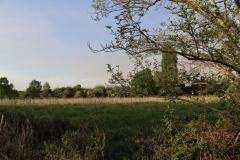There was to be no repeat of the 1914 Christmas Truce in any theatre of war. Bad weather and orders from above certainly ensured nothing at all friendly on the Western Front. Twenty-six local men had died in 1915 including 2 this month.
It was Gallipoli again that took its toll. Private Gilbert Edward Davies (2781) of the 1/7th Cheshires died on the first of the month. He is commemorated on the Helles Memorial, at Alderley Edge and on the family grave in St Bart's graveyard. Before the war he was a joiner and lived at 21 Chapel Street, Alderley Edge with his father John, mother Mary Ann, his 2 brothers and 4 sisters.
The last fatality of the year occurred on 22nd December when Private William Herbert Lee (3207) of the 1/7th Manchesters died aged 33. Twelve Tree Copse Cemetery is where his grave can be found. Commemorations are on the Civic Memorial and inside St Bart's. William was the son of William and Isabella Newton Lee originally from Crumpsall. His father was a wholesale clothier and it would appear they were an affluent family as by 1911 they had moved to Wilmslow like many factory owners. They lived in "Woodside", Hawthorn Lane, with a cook and a domestic servant. William, himself, was a rubber manufacturer and his brother produced cotton. There were 2 sisters of "independent means".
William was clearly killed during the evacuation of Gallipoli, ironically the best executed segment of the entire disastrous campaign. Following advice from Monro and Kitchener the Cabinet ordered us to leave – Anzac Cove and Suvla Bay by 20th December and Cape Helles by 31st. The last of our soldiers left Lancashire Landing on 9th January 1916.
The campaign failed to secure a passage through the Dardanelles. Its objectives were ill defined. Planning was poor. Logistics and equipment, especially artillery, were inadequate. The brave, but often inexperienced troops made the best they could of poor intelligence and tactical deficiencies. They fought magnificently in a doomed cause – indeed lions led mainly by donkeys. For the Australians and New Zealanders, Gallipoli became an affirmation of nationhood – they lost 11,500 men overall. Other Allies paid an even higher price however, we lost 34,000 and the French sometimes airbrushed out of the campaign 10,000, the Indians 1,400. The 250,000+ Allied casualties were exceeded by those of the Turks. Nevertheless the victory encouraged the Ottoman Empire. They began a campaign which led to us being surrounded at Kut in Mesopotamia.
Leadership changes ensued on our side. Churchill resigned from the government in November and joined the front line troops as a lieutenant colonel of the Royal Scots Fusiliers in January 1916. Kitchener's reputation waned. Asquith struggled on. Sir John French resigned as Commander in Chief of the troops on the Western Front and was replaced by Haig. What would the New Year bring?
Photos: Helles Memorial, Private Gilbert Edward Davies on the memorial, Twelve Tree Copse Cemetery and Private William Herbert Lee's grave.
Jon Armstrong and Alan Cooper
Wilmslow Historical Society
with photos taken in Gallipoli by Martin Smith













